Online Anomaloscope Color Blindness Test
Unleash Your True Colors: Take the Online Anomaloscope Color Blindness Test Today!
An online anomaloscope is a digital version of the traditional anomaloscope, which is a medical instrument used to diagnose color vision deficiencies or color blindness. The online anomaloscope typically presents a series of colored lights to the user and asks them to adjust the intensity of two colors to match a third color.
This color blindness test is based on the principle that people with different types of color blindness will have different levels of difficulty matching certain colors. Online anomaloscopes can be useful tools for individuals who suspect they may have color vision deficiencies or for researchers who need to test a large number of people quickly and easily. However, they should not be used as a substitute for a comprehensive eye exam conducted by a qualified eye doctor.
The online anomaloscope is a very simple red-green color blindness test. Try to match 7 pairs of colors. You can get a match using the slider. If you get an exact match, click Match. If you can't, use the "Cannot match" button.
This test is just a demonstration of the original anomaloscope. Its performance is not comparable to the original instrument. The analoscope uses 3 monochromatic primary colors (670nm - red, 546nm - green and 589nm - yellow), while yellow in the online version is a mixture of red and green.
Because every color on a computer screen is made up of three primary colors, red, green, and blue, an anomaloscope cannot be reproduced online. So this is just a simple reproduction, due to the different operating principle.The larger the area, you can find that matches the reference color, the more severe your color blindness will be.

Anomaloscope
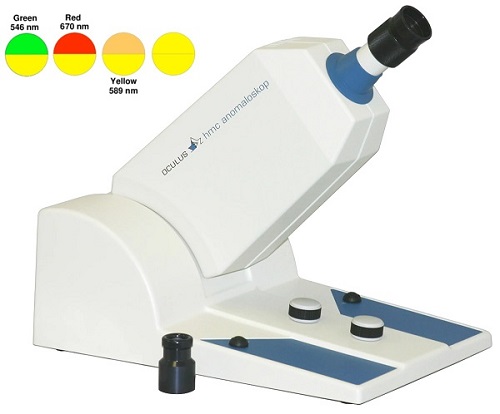
The first anomaloscope was developed in the 20th century and since then it is the most accurate color blindness test instrument used by eye specialists all around the world.
How it Works
An anomaloscope is based on a color match. Two different light sources have to be matched to the same color. On one side you have a yellow color which can be adjusted in brightness. The other side consists of a red and a green light whereas the proportion of mixture is variable.
The anomaloscope allows evaluation of an individual’s Rayleigh matches, ie the proportions of red and green light that need to be mixed to match a yellow. The currently available Neitz OT and Oculus Heidelberg anomaloscopes are designed to perform in the same way as the original Nagel anomaloscope, which is no longer available.
The patient is presented with a bi-field, one half composed of a mixture of red and green lights, the other a yellow light. The proportion of red and green lights in the mixture and the intensity of the yellow light are adjustable. The patient can be asked to perform free matches, ie control both the top and the bottom field until a match is obtained.
However, more commonly, the practitioner sets the red/green mixture and the patient will attempt to make a match by changing only the luminance of the yellow field.
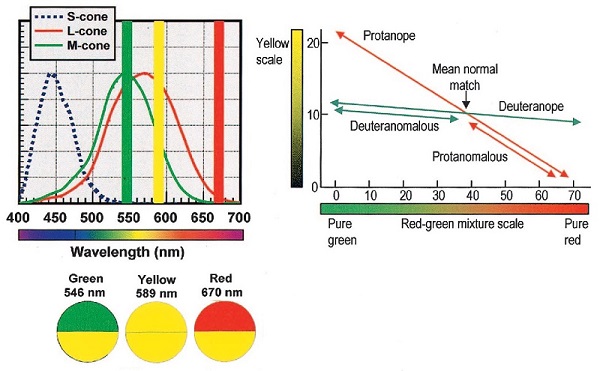
Normal Observer
An observer with normal color vision will accept only a narrow range of matches. With a scale of 0 (pure green) to 73 (pure red), the normal match will be around 42 units.
Anomalous Trichromats
The anomalous trichromat will need a different proportion of red and green lights to match the yellow than the normal observer; the protanomalous observer will need more red in the mixture whereas the deuteranomalous trichromat will need more green.
Dichromats
The dichromat will be able to match the yellow to a pure red, pure green and all mixtures in between by simply adjusting its intensity. Protan observers will turn down the intensity of the yellow light when matching the field to a red one. This is caused by their reduced sensitivity to red light.
A Rayleigh equation anomaloscope will therefore separate normals from color deficient observers, protans from deutans and anomalous trichromats from dichromats.
Most anomalous trichromats will show not only a shifted mid-point but also a greater range of accepted matches than individuals with normal colour vision. The extent of the matching range is an indicator of the severity of the defect, with a larger range reflecting a more severe defect.
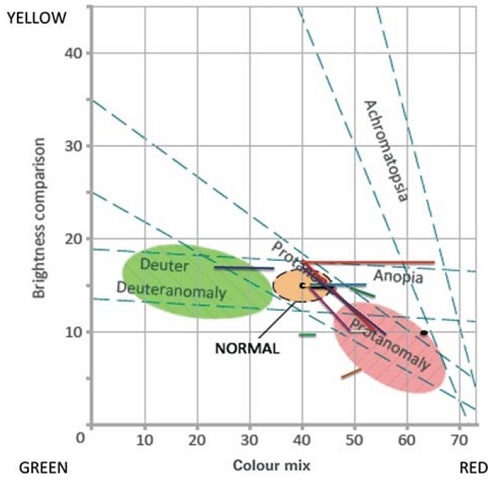
Tritans
Attempts have been made to develop equations for the evaluation of tritan deficiencies, but these have been problematic, as the region within which the match has to be made is trichromatic, and is also subject to the effects of lens and macular pigments. The Oculus Heidelberg anomaloscope incorporates the Moreland equation: a mixture of blue and green lights to match a blue-green light.
About the Tritan (blue) color blind testKeep in mind that this test is not a clinical diagnosis. Only a professional in a controlled environment can provide such a diagnosis. The goal of this test is to find where the gap is located in the “C shape” (known as a “Landolt Ring”) and to click on it.
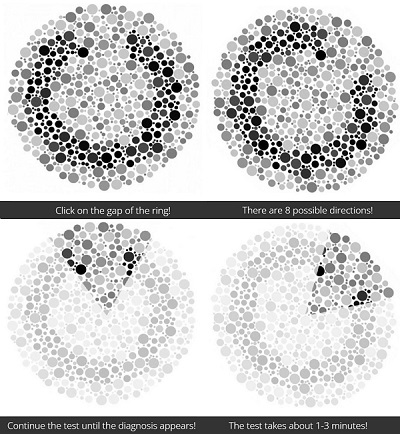
The test contains a series of images. Based on the test results, we generate a color spectrum as you may see (and display it next to a normal one). In case of tritan type color blindness, you probably won't notice (too much) difference between the two spectrums, but people with normal color vision will see the difference. The diagnosis and the two spectrums will appear at the end. It is only for tritan type of color vision deficiency.
Sensitivity of the Tritan (blue) color blind testThe maximum score available on the test is 10. The number of errors allowed is 2, The test has a sensitivity of 84.21%, a specificity of 95.83%, a positive predictive value of 94.12%, and a negative predictive value of 88.46%.
Based on my measurements, the online tritan color blind test has a lower efficiency than the original Colorlite test book (96.25%), however, this difference is still acceptable. The test detects tritan type of color blindness with adequate efficiency.
| Error Allowed | 2 |
| Sensitivity | 84,21% |
| Specificity | 95,83% |
| Positive predictivity | 94,12% |
| Negative predictivity | 88,46% |
How people see color with tritan type of colorblindness?
As the tritan form of colorblindness becomes more severe, a tritan colorblind person will see the following. The blue colors become less vibrant. Yellow is seen as white and green is seen as turquoise. The blue component of the purple disappears and becomes reddish.
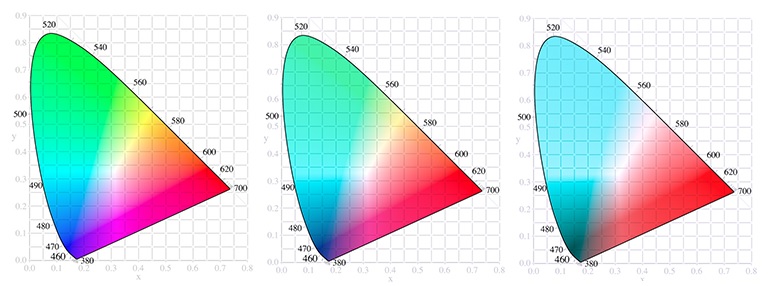
Color blind diagnostic and correction system for eye care professionals
What It is?
Opticians can now help colorblind people see color. The Colorlite Color Blindness Diagnostic and Correction System is for eye care professionals who want to help those with color deficiencies in their practice. With this system, you can give a diagnostic exam to determine the specific color deficiency a patient has. Based on the results, you can prescribe to your patent the optimal lens to correct their color blindness.
What It Includes?
Colorlite color blind test bookColorlite trial lensesWith the patient, you work through the different lenses and diagnostics to determine the patient’s exact type and severity of their color vision blindness. Within 20 minutes, you’ll find the best lenses for the patient!
Why It Matters?
This is a simple, revolutionary means helps eye care professionals help patients get the lenses they need to correct color-blindness. Instead of waiting for a diagnosis, you can do this right here in your office, and help your patients see in color faster than ever! Order today, and help your patients see color again with Colorlite’s revolutionary kit.
Conclusion
Online anomaloscope color blindness tests can be a convenient and useful tool for individuals who want to check for color vision deficiencies or for researchers who need to test large groups of people.
However, it's important to note that these tests are not a substitute for a comprehensive eye exam conducted by a qualified eye doctor.
If you suspect you may have color blindness, it's important to see an eye doctor who can provide a proper diagnosis and recommend appropriate treatment options if necessary..
To know more about anomaloscope color vision test, refer youtube.